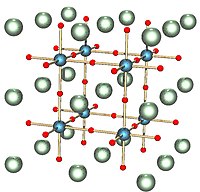
Photo from wikipedia
(Ba,Ca)(Ti,Zr)O3 solid solutions are promising lead-free piezoelectrics near their polymorphic phase boundary, which is believed to be linked to the interplay between B-site driven ferroelectricity and A-site driven ferroelectricity. Focusing… Click to show full abstract
(Ba,Ca)(Ti,Zr)O3 solid solutions are promising lead-free piezoelectrics near their polymorphic phase boundary, which is believed to be linked to the interplay between B-site driven ferroelectricity and A-site driven ferroelectricity. Focusing on (Ba,Ca)TiO3, we support this picture from first-principles calculations. In particular, we show how steric effects related to the partial substitution of Ba by Ca largely enhance the Ca-driven ferroelectricity, already virtually allowed in the parent CaTiO3. The emergent interplay between the Ca-driven and Ti-driven mechanisms lowers the energy barrier between different polar states, which eventually results in a quasi-isotropic polarization under substitution of a small concentration of Ba by Ca. A sizeable enhancement of the piezoelectric response directly results from these features.(Ba,Ca)(Ti,Zr)O3 solid solutions are promising lead-free piezoelectrics near their polymorphic phase boundary, which is believed to be linked to the interplay between B-site driven ferroelectricity and A-site driven ferroelectricity. Focusing on (Ba,Ca)TiO3, we support this picture from first-principles calculations. In particular, we show how steric effects related to the partial substitution of Ba by Ca largely enhance the Ca-driven ferroelectricity, already virtually allowed in the parent CaTiO3. The emergent interplay between the Ca-driven and Ti-driven mechanisms lowers the energy barrier between different polar states, which eventually results in a quasi-isotropic polarization under substitution of a small concentration of Ba by Ca. A sizeable enhancement of the piezoelectric response directly results from these features.
Journal Title: Applied Physics Letters
Year Published: 2019
Link to full text (if available)
Share on Social Media: Sign Up to like & get
recommendations!